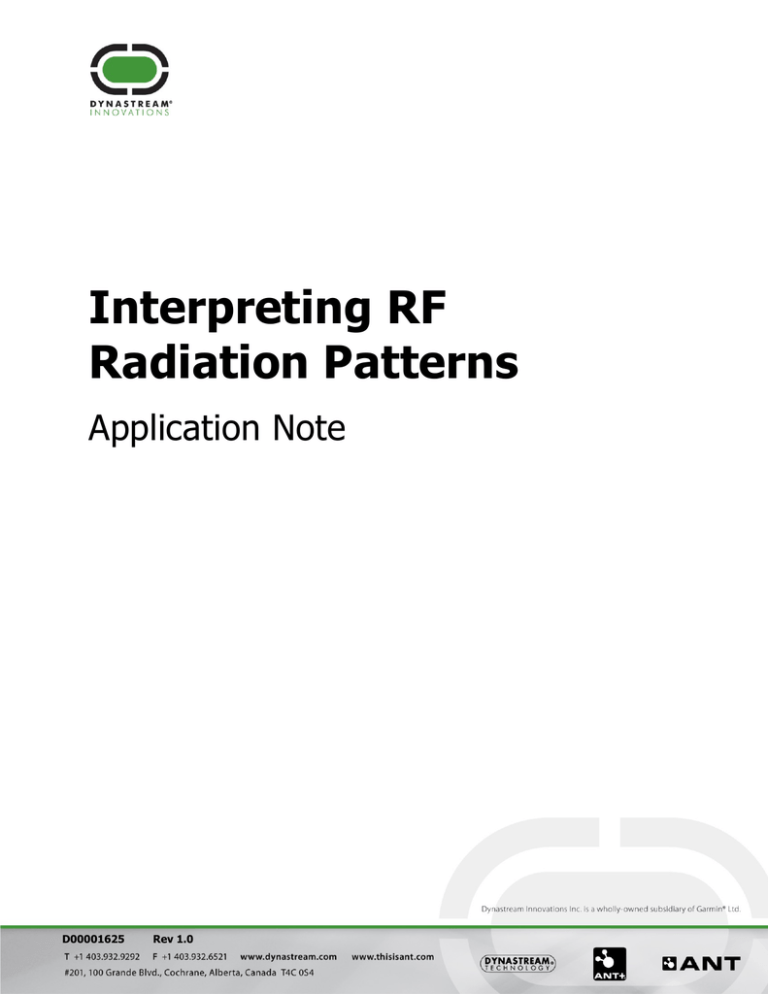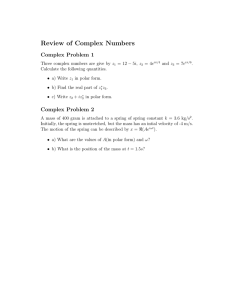
Interpreting RF
Radiation Patterns
Application Note
D00001625
Rev 1.0
Page 2 of 9
Interpreting RF Radiation Patterns, Rev 1.0
Copyright Information and Usage Notice
This information disclosed herein is the exclusive property of Dynastream Innovations Inc. No part of this publication may
be reproduced or transmitted in any form or by any means including electronic storage, reproduction, execution or
transmission without the prior written consent of Dynastream Innovations Inc. The recipient of this document by its
retention and use agrees to respect the copyright of the information contained herein.
The information contained in this document is subject to change without notice and should not be construed as a
commitment by Dynastream Innovations Inc. unless such commitment is expressly given in a covering document.
The Dynastream Innovations Inc. ANT Products described by the information in this document are not designed, intended,
or authorized for use as components in systems intended for surgical implant into the body, or other applications intended
to support or sustain life, or for any other application in which the failure of the Dynastream product could create a situation
where personal injury or death may occur. If you use the Products for such unintended and unauthorized applications, you
do so at your own risk and you shall indemnify and hold Dynastream and its officers, employees, subsidiaries, affiliates, and
distributors harmless against all claims, costs, damages, and expenses, and reasonable attorney fees arising out of, directly
or indirectly, any claim of personal injury or death associated with such unintended or unauthorized use, even if such claim
alleges that Dynastream was negligent regarding the design or manufacture of the Product.
©2014 Dynastream Innovations Inc. All Rights Reserved.
dynastream.com thisisant.com
Interpreting RF Radiation Plots, Rev 1.0
Page 3 of 9
Revision History
Revision
1.0
Effective Date
September 2014
Description
First Release
dynastream.com thisisant.com
Page 4 of 9
Interpreting RF Radiation Patterns, Rev 1.0
Table of Contents
1
Introduction .................................................................................................................................................................5
2
RF Antenna Patterns ....................................................................................................................................................5
3
Variations of Polar Plots ..............................................................................................................................................7
4
Summary.......................................................................................................................................................................9
List of Figures
Figure 2-1 Antenna Gain (dBi) .................................................................................................................... 5
Figure 2-2 Example 3D Radiation Pattern .................................................................................................... 5
Figure 2-3 Cross Section along XY Plane...................................................................................................... 6
Figure 2-4 Polar Plot of XY Plane Cross Section ............................................................................................ 6
Figure 2-5 Three Perpendicular Planes ........................................................................................................ 7
Figure 3-1 Radiation Pattern Alternate View ................................................................................................ 7
Figure 3-2 Projection of RF Data ................................................................................................................. 8
Figure 3-3 Projected Polar Plot.................................................................................................................... 8
Figure 3-4 True Cross Section Vs Projection ................................................................................................ 9
dynastream.com thisisant.com
Interpreting RF Radiation Plots, Rev 1.0
1
Page 5 of 9
Introduction
RF antenna radiation patterns can be presented in several ways; manufacturer datasheets will use different scales, views,
number of data points, etc. Interpreting the patterns and knowing how the data translates to performance characteristics
may therefore be difficult. Understanding how these plots are generated can enable the developer to interpret the data
properly.
2
RF Antenna Patterns
Figure 2-1 illustrates an antenna radiation pattern. These types of diagrams, typically referred to as polar plots, are offered
on datasheets to denote antenna performance.
Figure 2-1 Antenna Gain (dBi)
Polar plots are derived from 3-dimensional radiation data. Figure 2-2 below is an example 3D pattern with the RF source
located at the origin. Note that the power highlighted in green indicates a low power region (shown dipping towards the
origin), while the higher levels are indicated in red (protruding outwards).
Figure 2-2 Example 3D Radiation Pattern
dynastream.com thisisant.com
Page 6 of 9
Interpreting RF Radiation Patterns, Rev 1.0
Taking a cross section through the origin (e.g. the XY plane as shown in Figure 2-3) and plotting the points that lay on this
plane creates a polar plot of real emitted power values (Figure 2-4). Normally no additional processing is applied to these
polar plots and they offer the true depiction of the antenna performance along the plane described by the cross section.
Figure 2-3 Cross Section along XY Plane
Figure 2-4 Polar Plot of XY Plane Cross Section
To provide a complete representation of the RF performance datasheets will typically provide three polar plots with planes
defined as seen in Figure 2-5. The cross sections in this figure are defined as planes intersecting the origin along the XY
(green), YZ (pink), and XZ (grey) planes. These planes display data points along all three axes in space which gives the
developer a precise illustration of the antenna performance.
dynastream.com thisisant.com
Interpreting RF Radiation Plots, Rev 1.0
Page 7 of 9
Figure 2-5 Three Perpendicular Planes
3
Variations of Polar Plots
Interpretation problems for developers can occur when a different method than the one described above is used to
generate polar plots.
Consider the same example 3-D radiation pattern as above rotated so the line of sight is along the Z-axis. In this case the
field of view will appear as seen in Figure 3-1.
Figure 3-1 Radiation Pattern Alternate View
dynastream.com thisisant.com
Page 8 of 9
Interpreting RF Radiation Patterns, Rev 1.0
Note that at this angle it is impossible to see the true performance along the XY plane because the nulls can be hidden by
peaks at other angles of elevation along the Z-axis (Figure below).
Figure 3-2 Projection of RF Data
The sample RF data point effectively becomes projected onto the XY plane. The magnitude of the point projected is larger
than the actual value of the RF data point that exists on that plane.
The resultant polar plot representation of that plane is shown in the figure below.
Figure 3-3 Projected Polar Plot
dynastream.com thisisant.com
Interpreting RF Radiation Plots, Rev 1.0
Page 9 of 9
Figure 3-4 is a comparison between the true polar plot and the plot above.
Figure 3-4 True Cross Section Vs Projection
If a manufacturer generates a plot by projecting the data onto a plane as opposed to taking a true cross section of the 3-D
pattern the resultant polar plot can present a far too ideal depiction of what is actually radiated by the source.
4
Summary
Datasheets provide radiation patterns to denote the RF performance of a module. Displaying the radiation data using
methods that do not show actual values from each of the cross sections is not conducive for developers attempting to
optimize RF performance. This application note can be used to assist in proper interpretation of RF radiation patterns.
dynastream.com thisisant.com


